Accepted Scientific Name: Aloe microstigma Salm-Dyck
Monogr. Gen. Aloes & Mesemb. [Salm-Dyck] Sect. 26:fig 4 (fasc. 6:fig11) 1854 Salm-Dyck
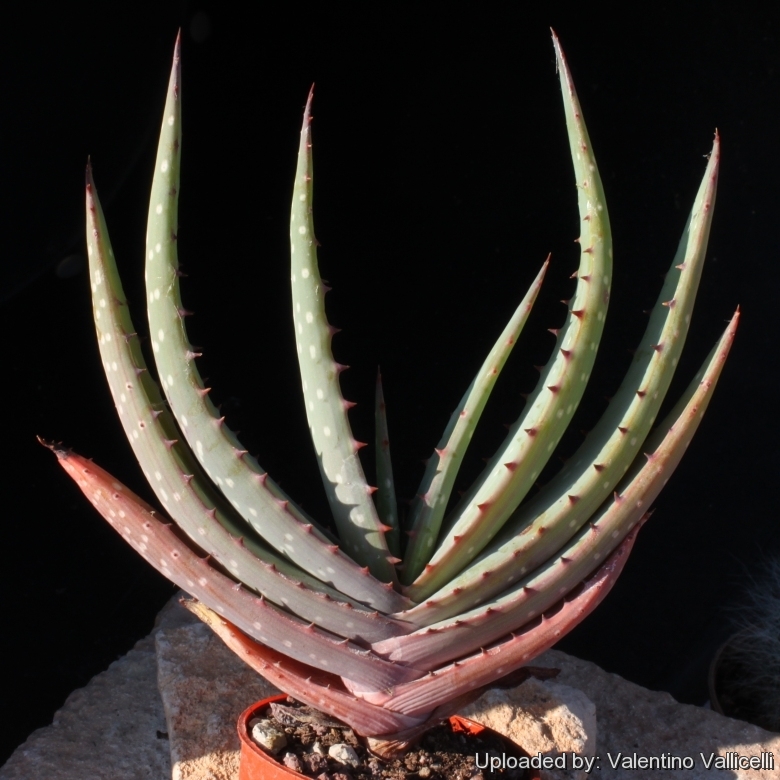
Aloe khamiesensis Photo by: Valentino Vallicelli
Origin and Habitat: Khamieskroon in Kamiesberg mountains and elsewhere in Namaqualand, Southern Africa
Habitat: It grows in arid conditionscan in a variety of dry habitats comprising rocky places on the hills and mountains bolth in flat open areas, steep rocky slopes (often on the northern slopes), or amongst bushes, the soils are mostly granite- and sandstone-derived. Rainfall is in winter and averages about 250 mm per annum.
Ecology: It is pollinated primarily by sugar birds particularly the lesser double collard sugar bird which extracts the nectar produced by the flowers. Insects may also be responsible for pollination. Seeds are produced in abundance and this serves as a survival mechanism. Seeds are parasitized by small day flies that lay their eggs in the seeds, their larvae then live off the seeds. The success of germination is relatively high giving rise to the abundance of the species. The rosette of leaves helps to cool the plant in that the upper leaves provides shading for the lower ones. Another interesting adaptation is the inward folding of leaves during the hot summer months. This helps to protect the softer and younger leaves from extreme temperatures. Leaves unfold again in cool weather.
Synonyms:
See all synonyms of Aloe microstigma
back
Accepted name in llifle Database:Aloe microstigma Salm-DyckMonogr. Gen. Aloes & Mesemb. [Salm-Dyck] Sect. 26:fig 4 (fasc. 6:fig11) 1854Synonymy: 5
Accepted name in llifle Database:Aloe microstigma subs. framesii (L. Bolus) Glen & D.S.HardyFl. S. Africa 5(1: 1): 107 2000Synonymy: 3
back
Common Names include:
ENGLISH: Khamiesberg Aloe, Namaqua Aloe
AFRIKAANS (Afrikaans): Tweederly, Kamiesberg-alwyn, Aloeboom
Description: Plants are erect and up to 3 m tall, usually single-stemmed with only one rosette.
Stem: Stout about 10 cm. in diameter at the base, 120-200 cm. high, but occasionally up to 3 m tall or more, simple, but sometimes the stem is branched into two or three.
Leaves: Crowded at the end of the stem, pale green to dull-green, flat and relatively narrow 40(or more) cm long, 5-8 cm. wide at the base, 1 cm. thick near the base. At their base the leaves curve upwards and at their tips they curve outward. They are densely spotted with small white spots present on the upper and lower surface of the leaves. Margins with sharp, small, reddish brown, triangular teeth.
Inflorescence: Complex with 4 to 8 branches (racemes) The racemes are strongly triangular and about 300 mm long.
Flower: Tubular, bright orange-red, in some specimens the flower tips are tinged a greenish-yellow colour.
Blooming season (Europe): Winter
Seeds: Small, 8 mm x 4 mm, and are produced in abundance inside the fruit capsules that split into three when ripe. They are winged enabling them to be dispersed by the wind.
Fruiting season (Europe): Spring.
Remarkas: Aloe khamiesensisSN|639]]SN|22349]] have now been included under Aloe microstigmaSN|22349]]SN|639]] subsp. microstigma.
Subspecies, varieties, forms and cultivars of plants belonging to the Aloe microstigma group
 Aloe khamiesensis Pillans: Plants are erect and up to 3 m tall, usually single-stemmed with only one rosette. Distribution: Khamieskroon in Kamiesberg mountains and elsewhere in Namaqualand.
Aloe khamiesensis Pillans: Plants are erect and up to 3 m tall, usually single-stemmed with only one rosette. Distribution: Khamieskroon in Kamiesberg mountains and elsewhere in Namaqualand. Aloe microstigma Salm-Dyck: occur singularly or in small groups, up to 50 cm in diameter and 60-70 cm tall. Distribution: Western and Eastern Cape (Little Karoo, Noorsveld)
Aloe microstigma Salm-Dyck: occur singularly or in small groups, up to 50 cm in diameter and 60-70 cm tall. Distribution: Western and Eastern Cape (Little Karoo, Noorsveld)
Bibliography: Major references and further lectures
1) Stuart Max Walters “The European Garden Flora: Pteridophyta, Gymbospermae, Angiospermae-Monocotyledons” Cambridge University Press, 1984
2) Urs Eggli “Illustrated Handbook of Succulent Plants: Monocotyledons” Springer, 2001
3) John Robert Brown “Unusual plants: 110 spectacular photographs of succulents” Abbey Garden Press, 1954
4) Pauline Bohnen “Flowering plants of the Southern Cape” Still Bay Trust, 1986
5) John C. Manning, Colin Patterson-Jones “Jewels of the Veld” Struik, 2004
6) John (John C.) Manning “Field guide to fynbos” Struik, 2007
7) Hans Bornman, David S. Hardy “Aloes of the South African veld” Voortrekkerpers, 1971
8) Sean Hogan, Timber Press (Portland, Or.) “Flora: a gardener's encyclopedia” Vol. 1 Timber Press, 2003
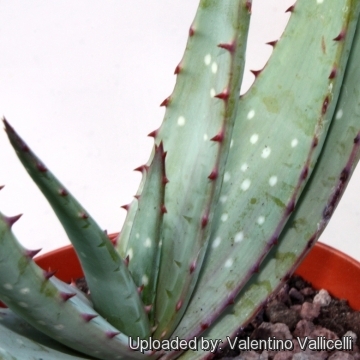 Aloe khamiesensis Photo by: Valentino Vallicelli
Aloe khamiesensis Photo by: Valentino Vallicelli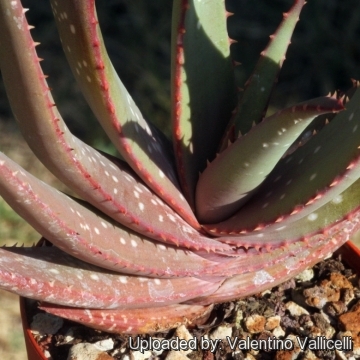 Aloe khamiesensis Photo by: Valentino Vallicelli
Aloe khamiesensis Photo by: Valentino Vallicelli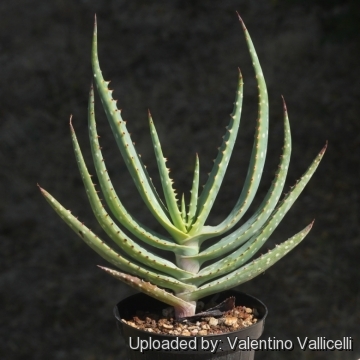 Aloe khamiesensis Photo by: Valentino Vallicelli
Aloe khamiesensis Photo by: Valentino Vallicelli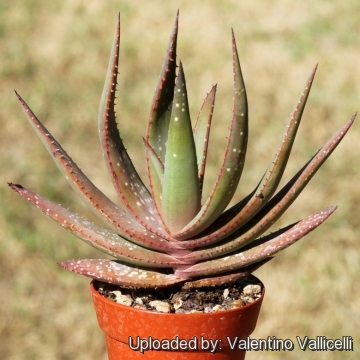 Aloe khamiesensis Photo by: Valentino Vallicelli
Aloe khamiesensis Photo by: Valentino Vallicelli Aloe khamiesensis Photo by: Valentino Vallicelli
Aloe khamiesensis Photo by: Valentino Vallicelli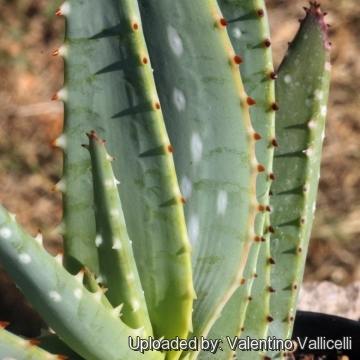 Aloe khamiesensis Photo by: Valentino Vallicelli
Aloe khamiesensis Photo by: Valentino VallicelliCultivation and Propagation: Aloe khamiesbergensis does not do well in general cultivation, specialist care is required for it to grow well. It can be grown in large containers.
Growth rate: It grows slowly, but not agonisingly so being able to increase their height by 10- 30 (or more) cm per year under favourable conditions.
Soil: Always use a good quality, loamy sandy soil with plenty of drainage chips at the bottom of containers.
Watering: It tolerates weekly watering in the summer; once a month, or not at all in the colder months of December and January. Can withstand long periods of drought, but it will thrive and flower more profusely if watered in the correct season. Incorrect watering, poor drainage or too much shade can lead to attack by pests and diseases.
Hardiness: it can take a few degrees of frost in winter as well, but prefer hot summers. It grows much better outdoors in spring and summer. In mild climates it can be cultivated outdoors for use in landscaping, preferably planting it in hot and dry rock gardens. it will grow best in regions with a climate close to that of its native deserts not too cold, and not too wet.
Gardening: This aloe can be grown in large, rocky, well-drained soil in gardens in drier areas. It is very drought resistant but susceptible to frost. They make particularly nice low maintenance garden plants which are especially attractive when in flower in the barren winter months.
Medicine: It is not recorded as a medicinal plant but it is said that the bitter sap has healing properties in cases of cuts and burn wounds.
Propagation: Almost exclusively by seeds planted in autumn, in trays of coarse river sand. Truncheons (if available) can also be used for propagation. Truncheons must be dried out for at least 3 weeks before planting in river sand. This is quite a difficult alternative and success is not always guaranteed.
















